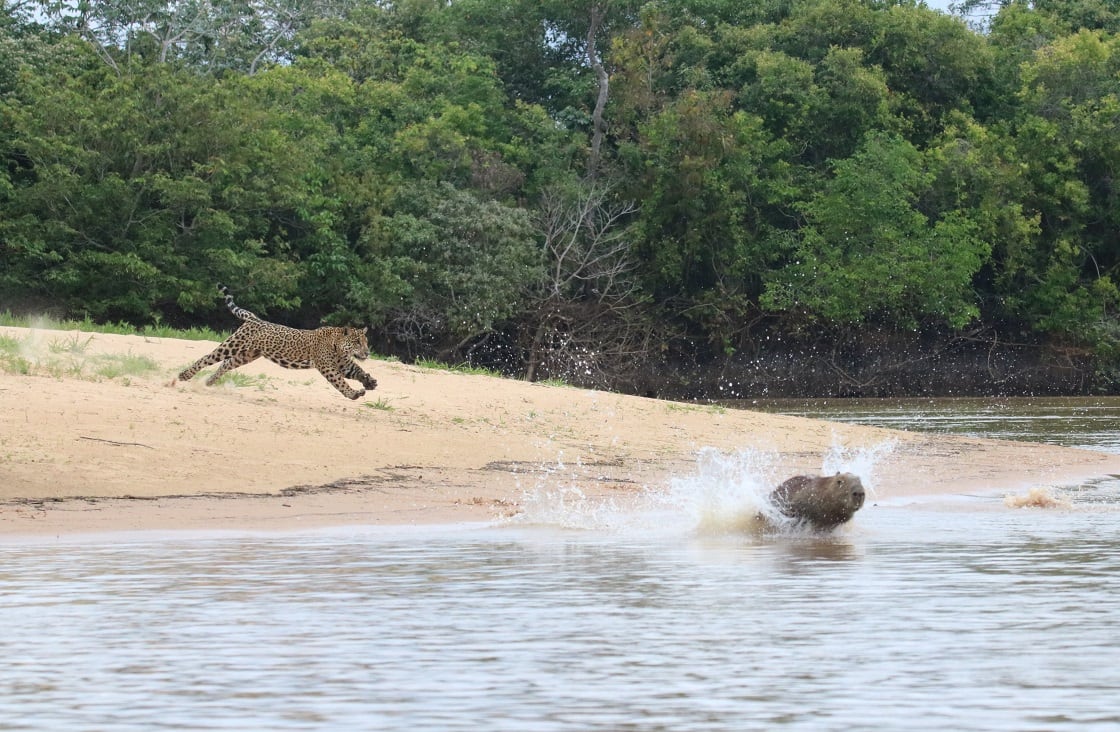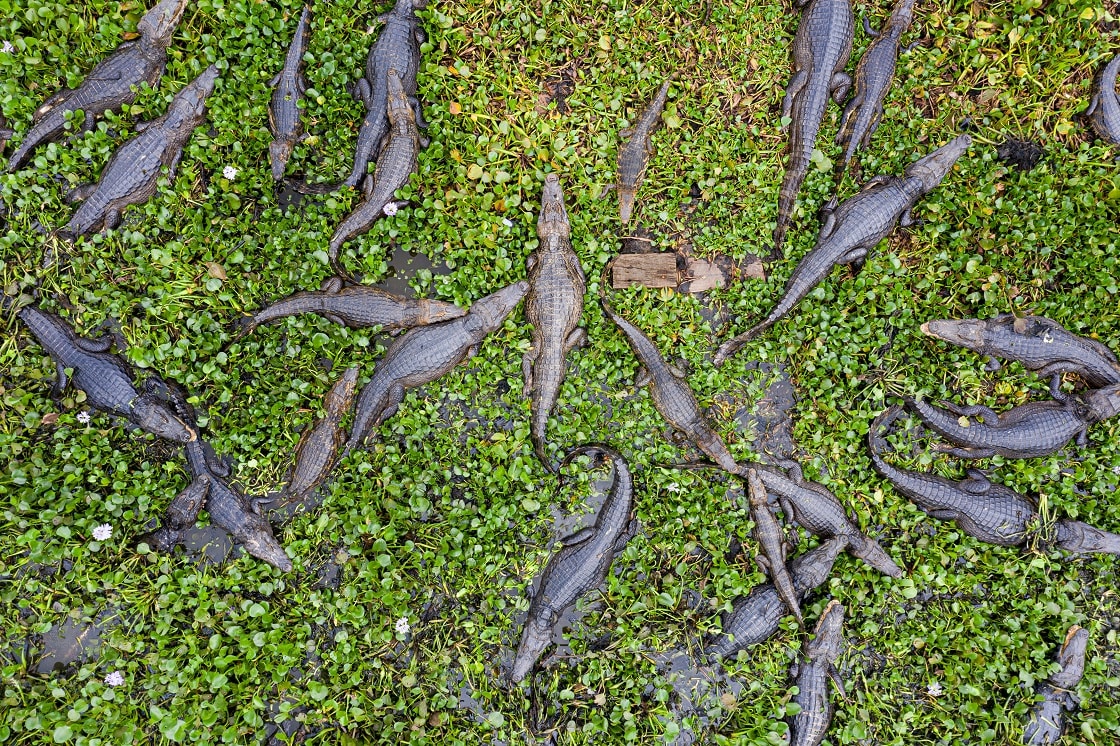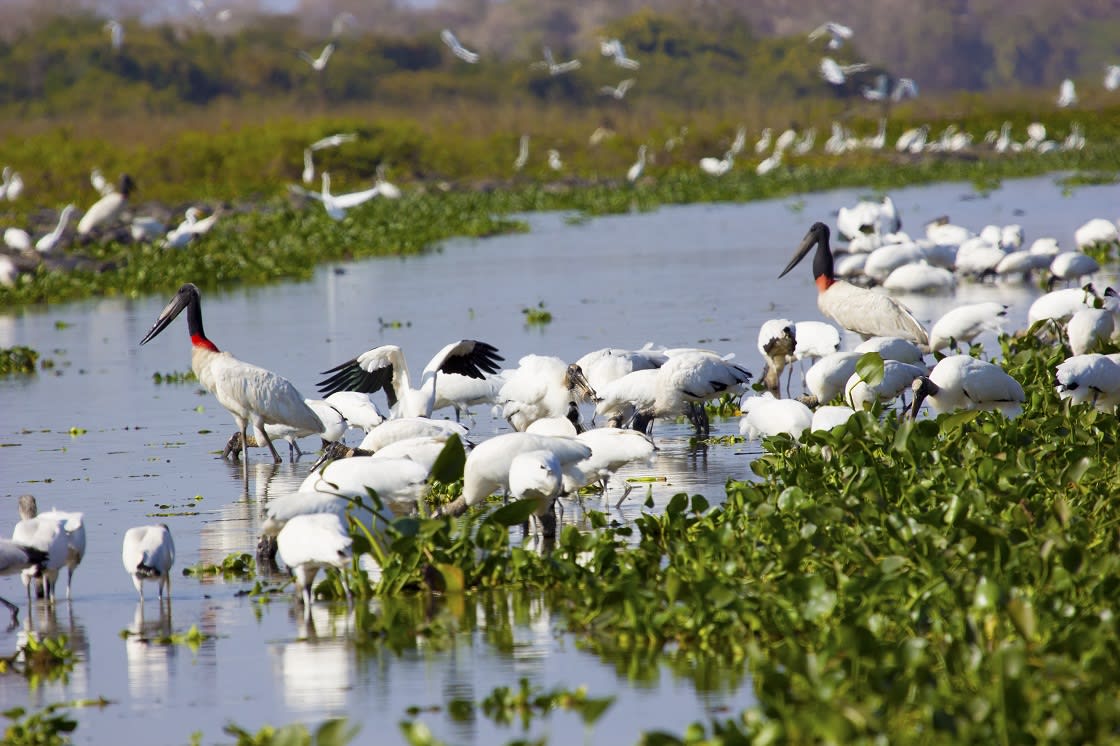
Covering over 81,000 square miles across Brazil, Bolivia, and Paraguay, the Pantanal Region is as vast as it is fascinating. Overflowing with birds, vibrant vegetation, and exotic animals lurking in the marshes, it’s a remarkable natural wonder that few know about. For those that do, one of its biggest draws is that spotting wildlife is relatively easy due to its flat landscape.
While the Pantanal can’t compete with the Amazon from a biodiversity standpoint (not many places can!), this wetland offers more extensive wildlife-watching opportunities, given the wide-open sightlines of the waterways and savannas in comparison to the dense foliage of the Amazon, and the incredibly productive ecosystem. If there’s a spot in South America that has a “Serengeti” feel, a tour of the Pantanal comes closest.
So what wildlife lives in the Pantanal? You may be familiar with a certain spotted cat, but there’s quite the lineup of hefty animals that exist here in impressive densities. From the skies down to the ground, and into the water, the area is teeming with creatures of all shapes and sizes waiting to be spotted.

The jaguars of the Pantanal are what most visitors come to see
Of all Pantanal wildlife, none is more sought-after than the jaguar, the largest cat in the Americas and the third-biggest in the world after the tiger and lion. Without question, the Pantanal is the best place anywhere to see jaguars: a reflection of the wetland complex’s open habitat, its large, dense population of the big cats, and a certain level of habituation on the part of these magnificent beasts to the sight of mostly boat-bound tourists.
Pantanal jaguars prey on a wide variety of creatures, but a goodly portion of their diet is composed of caimans: those Neotropical crocodilians that are close relatives of the American alligator. These jacare caimans hauled out in almost unbelievable numbers, jaws agape, present a quintessential Pantanal sight. Indeed a 1996 study revealed that there were 10 million caimans living in the Pantanal, making it the highest concentration of crocodilians in the world.

Aerial View Over Group Of Caimans In The Wild Pantanal
Jaguars will scout for caimans along the riverbanks or lakeshores, pouncing on them from above, or actively wade in the water on the hunt. Formidably armed as caimans are, they don’t stand much of a chance against the barrel-chested cat’s tremendous strength, gripping claws, and enormously powerful jaws (Jaguars have the strongest bite for their size among the big cats).
Jaguars are the stars, but there are other fascinating carnivores in the Pantanal, including the smaller spotted cat called the ocelot, the gangly canid called the maned wolf, and the dainty crab-eating fox. The world’s longest and second-heaviest otter, the giant otter, abounds in the Pantanal: Seeing one of these intelligent, rowdy, and highly social mustelids, another of the region’s top predators, is nearly as thrilling as a jaguar cameo.
The world’s biggest rodent, meanwhile, is also easily seen in the Pantanal: the semiaquatic capybara, resembling an incredibly oversized hamster or guinea pig (and often falling on jaguar menus). The largest deer in South America, the marsh deer, is another Pantanal resident: a handsome ungulate well adapted to this soggy countryside. And the heftiest land mammal on the continent, the South American or Brazilian tapir, also roams here.
Another incredibly distinctive representative of the Pantanal’s “megafauna” is the giant anteater, a hulking, long-snouted, shaggy-tailed beast that may weigh more than 100 pounds. This ant- and termite-muncher is surprisingly at home in the water, and with its formidable front claws can mount an active defense against jaguars and other potential predators.
There are other titans here outside of the mammalian realm: the green anaconda, the world’s biggest snake, as well as it’s somewhat smaller (but still very good-sized cousin) the yellow anaconda. As iconic a symbol of the Pantanal as the jaguar, the aforementioned jabiru is the largest, most regal stork in the Americas: a classic prize for Pantanal birders, as are the world’s largest parrot and toucan, the utterly spectacular hyacinth macaw, and toco toucan, which both find a precious refuge in the Kingdom of Waters. The biggest flightless bird in the Americas, the ostrich-like greater rhea, strides the grasslands and savannas of the Pantanal.

Jabiru Birds Eating At Pantanal
Ah, but there’s so much more, too: from agoutis and coatis to black howler monkeys and capuchins, from great congeries of egrets, herons, and spoonbills to those spear-billed “snakebirds” called anhingas, from helmeted manakins and wattled jacanas to snail kites and black hawks, not to mention the infamous red-bellied piranha. All told, more than 600 bird species call the Pantanal home as either residents, seasonal breeders, or migrants, with some 325 fish species, roughly 160 mammal species, nearly 100 reptile species, and about 50 amphibian species helping round out the animal roster.
Whilst famed for its mega-fauna, the Pantanal is also home to 3,500 known plant species that make their home in 12 unique sub-regional ecosystems. As you might imagine, with the name “Pantanal” – which comes from the Portuguese word pantano, which refers to a wetland, swamp, or marsh – the majority of these plants are aquatic plant species, especially during the rainy season, when the Pantanal’s floodplains are completely submerged and water levels rise between two and five meters (six to sixteen feet).
However, during the dry season, which is a great time to cruise the Pantanal, the floodplains drain to become grasslands, and a completely different set of plant species come to the fore. What’s even more remarkable is that this unique combination of plant communities are more typically found separately in surrounding (and wildly differing) biome regions, including tropical rainforest plants of the Amazon, woodland plants typical of the northeast of Brazil, and savanna plants native to the Chaco region in Bolivia and Paraguay. This combination of vegetation makes for a fascinating collection of ecosystems that, despite each possessing distinct hydrological, geological, and ecological characteristics, all work successfully in harmony.
Unfortunately, like many of the world’s natural environments, the Pantanal is currently threatened by a variety of human activities, both intentional and unintentional. Almost 99% of the land in the Pantanal is privately owned for the purpose of agriculture and ranching, with up to 8 million cattle living within it. This is leading to erosion and sedimentation that disrupt the flood-plain ecosystems, consequently threatening native species.
Pollution from the agriculture and gold mining industries is also harming native flora and fauna, making it difficult for the Pantanal’s natural water treatment system to function properly. Commercial fishing focused on just a few species is highly unsustainable, as is the sportfishing taking place in the Paraguay River. And most, unfortunately, the threat of hunters, poachers, and smugglers interested in illegal species continues, with reptiles, wild cats, and parrots holding a high value on the black market.
Fortunately, things are being done to help preserve it. In 2018, the Pantanal’s three countries formally signaled their shared commitment to sustainable governance of the wetlands when they signed the landmark Pantanal Declaration, a trilateral agreement stating their commitment to work together to reduce pollution, strengthen water governance, and expand scientific knowledge, all whilst ensuring the rights of the indigenous people who reside there.
This introduction to the wildlife of the Pantanal is far from exhaustive, as with so many incredible species found therein there are simply too many to list. The best way by far to learn about the wildlife in the Pantanal is to go and see it with your own eyes as part of a custom Brazil vacation package.
While Rainforest Cruises aim to provide accurate and up-to-date information, we make no representations as to the accuracy or completeness of any information herein or found by following any link on this site. Rainforest Cruises cannot and will not accept responsibility for any omissions or inaccuracies, or for any consequences arising therefrom, including any losses, injuries, or damages resulting from the display or use of this information.




